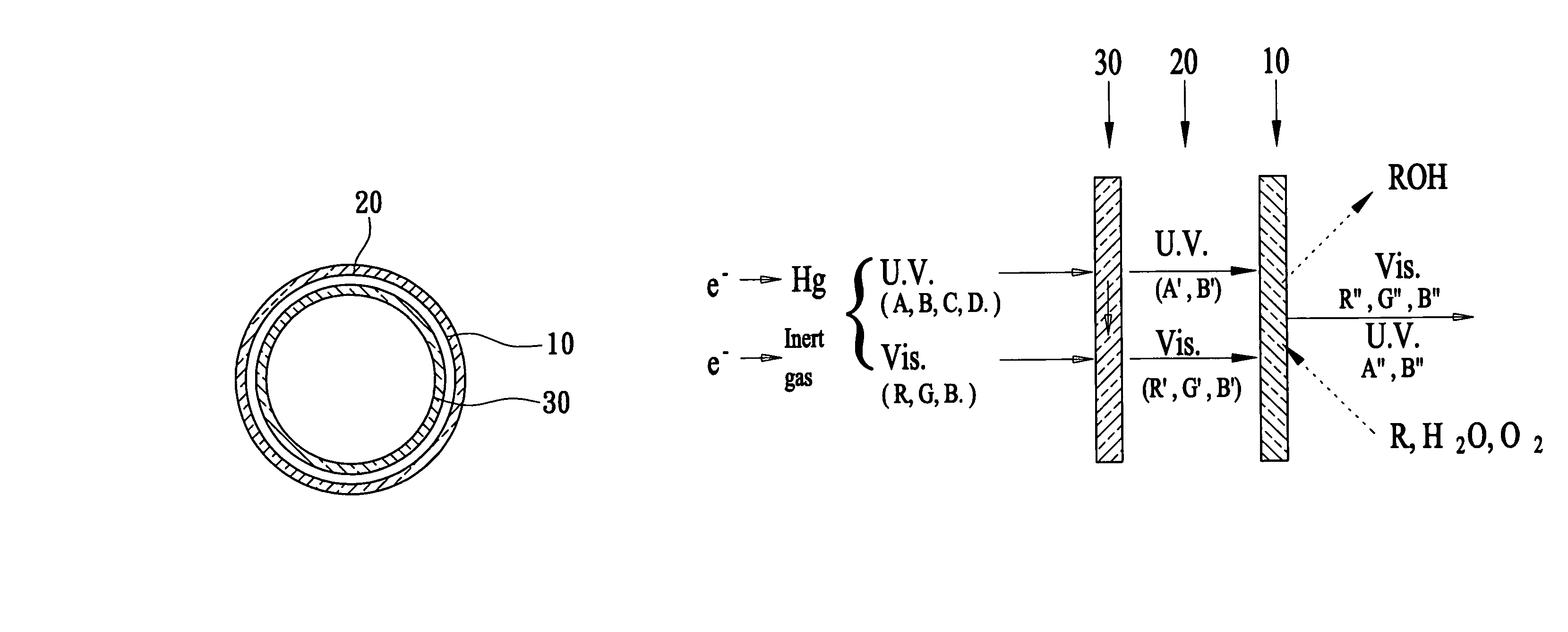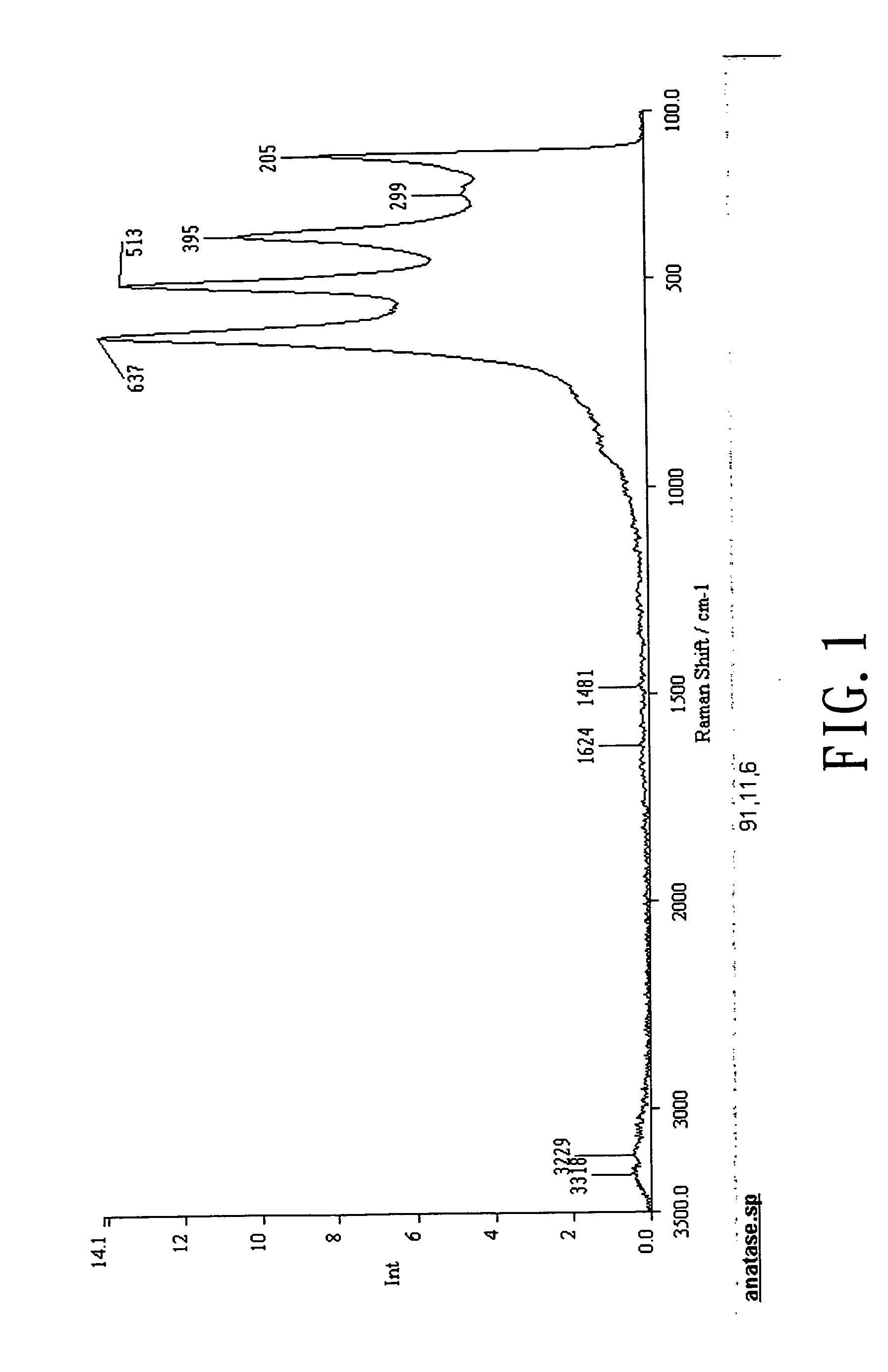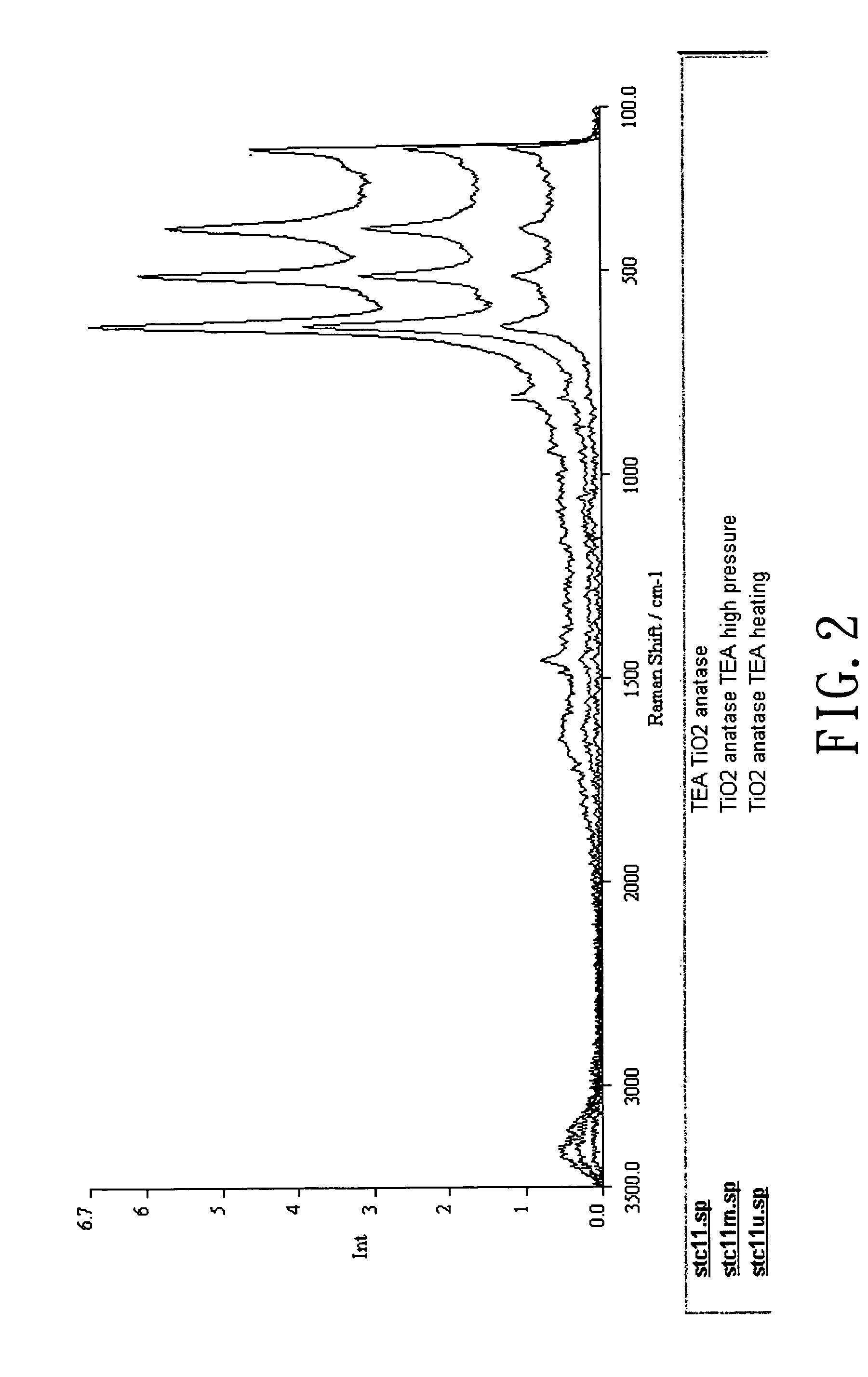Photocatalytic fluorescent lamp provided with an anatase TiO2 coating film
a fluorescent lamp and photocatalytic technology, applied in the field of fluorescent lamps, can solve the problems of difficult application of prior art photocatalysts in the field of air pollutant treatment for a living environment, impracticality of the reaction system when used in living environments, and complex equipment to handle, so as to improve the deodorization effect, improve the bactericidal and fungicidal activity, and improve the adhesion
- Summary
- Abstract
- Description
- Claims
- Application Information
AI Technical Summary
Benefits of technology
Problems solved by technology
Method used
Image
Examples
example 1
[0055]About 1 mole titanium alkoxide such as Ti(OR)4, where R is a hydrocarbon group, CnH2n+1 and n=1-5, and is, for example, methyl, ethyl, n-propyl, isopropyl, n-butyl, t-butyl, sec-butyl, pentyl and the like, is incorporated with chelating agents. Strong chelating agents such as organic acid RCOOH, Organic acetate CH3(O)CCH2C(O)R, amino acid RCH(NH2)COOH, succinic acid HOOCCH(R)COOH, and organic alcohol RC6H3(OCH3)OH are used. The amount of strong chelating agent added should be controlled to a chelating agent / Ti(OR)4 mole ratio of 0.01-2.0, and preferably 0.1-1.0. Preferably, the chelating agent is mixed with alcoholic solvent such as ethanol, propanol, iso-propanol, butanol, iso-butanol, or methanol before mixing with the titanium alkoxide. The amount of alcoholic solvent blended should be controlled to an alcoholic solvent / chelating agent mole ratio of 1-100, preferably diluted to a mole ratio of 10. The mixture of alcoholic solvent and the chelating agent is slowly mixed with...
example 2
[0061]1.0 mole titanium alkoxide is added into water for hydrolysis. The resultant solution has a H2O / titanium alkoxide mole ratio of about 100. The titanium alkoxide is hydrolyzed to become white HxTiO[(4−x) / 2+x].nH2O gel solution. After filtrating and then water-washing the hydrolysate solution, HxTiO[(4−x) / 2+x].nH2O gel is obtained, which is then diluted with water that is 0.1-1.0 times the weight of the gel. The pH value of the diluted gel solution is thereafter adjusted by alkaline substance such as NH4OH, N(R)4OH, or N(R)3. The pH value is adjusted to above 9.0-12.0. The alkaline substance / titanium alkoxide mole ratio is in a range of 0.05-0.5. After adjusting the pH value, the solution is stirred and heated in a hydrothermal reactor for 1-25 hours. The temperature of the hydrothermal is 100-250° C. After the hydrothermal, alkaline anatase TiO2 solution gel, which is a yellow transparent liquid, is obtained. The resultant anatase TiO2 sol contains 2-20 wt % TiO2. The thus-form...
example 3
[0068]In this example, spiral fluorescent lamps are used. The spiral-type single end fluorescent lamps are coated with anatase TiO2 by the above dip coating process to form a photocatalytic coating air cleaning fluorescent lamp. The air cleaning ability test is conducted in an 8-liter closed system. In the closed system, the spiral fluorescent lamp coated with anatase TiO2 is installed therein and 2 μL butyl acetate is injected. The lamp is turned on and the gas concentration is measured by standard equipment. The result is shown in Table 5.
[0069]
TABLE 5ButylacetateButyl acetateUVconcen-decompositionintensityTiO2 anatasetrationrate constant(mW / Lamp TypeSol Type(ppm)(min−1)cm2)Spiral lampas Example 1530.0270.18923 W, D-typeas Example 2530.06760.254Spiral lampas Example 1530.0040.21721 W, D-typeas Example 2530.07180.215Spiral lampas Example 1530.0210.47621 W, L-typeas Example 2530.14740.583
[0070]In this experiment, different spiral type lamps are dip coated in anatase TiO2 solution. T...
PUM
| Property | Measurement | Unit |
|---|---|---|
| particle size | aaaaa | aaaaa |
| temperature | aaaaa | aaaaa |
| temperature | aaaaa | aaaaa |
Abstract
Description
Claims
Application Information
 Login to View More
Login to View More - R&D
- Intellectual Property
- Life Sciences
- Materials
- Tech Scout
- Unparalleled Data Quality
- Higher Quality Content
- 60% Fewer Hallucinations
Browse by: Latest US Patents, China's latest patents, Technical Efficacy Thesaurus, Application Domain, Technology Topic, Popular Technical Reports.
© 2025 PatSnap. All rights reserved.Legal|Privacy policy|Modern Slavery Act Transparency Statement|Sitemap|About US| Contact US: help@patsnap.com



